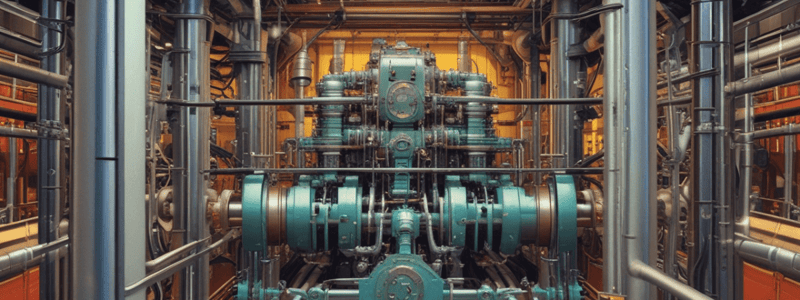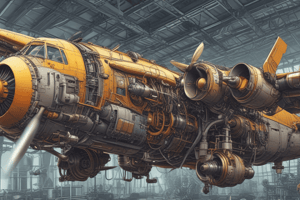Podcast
Questions and Answers
What is the primary purpose of the 'jaws of life' system?
What is the primary purpose of the 'jaws of life' system?
What is the term for the fixed point around which a lever pivots?
What is the term for the fixed point around which a lever pivots?
What determines the type or class of lever?
What determines the type or class of lever?
What is the mechanical advantage of a system where the length of the load arm is equal to the length of the effort arm?
What is the mechanical advantage of a system where the length of the load arm is equal to the length of the effort arm?
Signup and view all the answers
What is an example of a first class lever?
What is an example of a first class lever?
Signup and view all the answers
Why is there no mechanical advantage gained when using scissors?
Why is there no mechanical advantage gained when using scissors?
Signup and view all the answers
What is an example of a second class lever?
What is an example of a second class lever?
Signup and view all the answers
What is an example of a third class lever?
What is an example of a third class lever?
Signup and view all the answers
What is the mechanical advantage of a pair of tweezers?
What is the mechanical advantage of a pair of tweezers?
Signup and view all the answers
Why do we use levers?
Why do we use levers?
Signup and view all the answers
What is the primary purpose of using hydraulics and pneumatics?
What is the primary purpose of using hydraulics and pneumatics?
Signup and view all the answers
What is a common application of hydraulic systems?
What is a common application of hydraulic systems?
Signup and view all the answers
Why is water not often used in hydraulic systems?
Why is water not often used in hydraulic systems?
Signup and view all the answers
What is the primary difference between hydraulic and pneumatic systems?
What is the primary difference between hydraulic and pneumatic systems?
Signup and view all the answers
What is an example of a hydraulic and pneumatic tool used in rescue operations?
What is an example of a hydraulic and pneumatic tool used in rescue operations?
Signup and view all the answers
What is the principle behind any hydraulic system?
What is the principle behind any hydraulic system?
Signup and view all the answers
What is the purpose of the Jaws of Life rescue system?
What is the purpose of the Jaws of Life rescue system?
Signup and view all the answers
What type of fluid is used in hydraulic systems?
What type of fluid is used in hydraulic systems?
Signup and view all the answers
Why are hydraulic systems used for tasks like lifting a car or digging a ditch?
Why are hydraulic systems used for tasks like lifting a car or digging a ditch?
Signup and view all the answers
What is the main advantage of using hydraulic and pneumatic systems?
What is the main advantage of using hydraulic and pneumatic systems?
Signup and view all the answers
Study Notes
Hydraulics and Pneumatics
- Hydraulics is the use of liquid to convert a small force into a bigger force to get a mechanical advantage.
- The principle behind any hydraulic system is that a force applied at one point in the system is transmitted to another point in the system using a fluid such as water or oil.
- Water is not often used in hydraulic systems because it does not have good lubricating qualities.
- Hydraulic systems use an incompressible liquid to operate.
Pneumatics
- Pneumatics is the use of air or gas to convert a small force into a bigger force to get a mechanical advantage.
- Pneumatic systems use compressed air to operate.
Jaws of Life Rescue System
- The Jaws of Life is a collection of hydraulic and pneumatic tools used to open vehicles or buildings to rescue trapped victims.
- The system has saved countless lives of people trapped in vehicles or buildings following accidents.
Levers
Introduction
- A lever is a simple mechanism consisting of a rigid bar that pivots around a fixed point called a fulcrum.
- A lever can generate a much larger output force from a small input force.
Three Classes of Levers
- First class levers have the fulcrum in between the effort and the load.
- First class levers create the best possible advantage when trying to lift an object.
- Second class levers have the fulcrum at one end and the effort at the other end, and the load is between the effort and the fulcrum.
- Second class levers may provide mechanical advantage.
- Third class levers have an effort between the load and the fulcrum, and provide NO mechanical advantage.
Mechanical Advantage
- Levers may give us a mechanical advantage (MA), which means increasing the force available to do the useful work.
- Mechanical advantage is expressed as a number where 1 or less means there is no mechanical advantage and anything more than 1 means there is mechanical advantage.
- Mechanical advantage is calculated by comparing the length of the load arm to the fulcrum, the effort arm to the fulcrum, and the load and the effort.
Studying That Suits You
Use AI to generate personalized quizzes and flashcards to suit your learning preferences.
Description
Understand how mechanical systems use liquids or gases to convert small forces into larger forces, enabling tasks like lifting cars or digging ditches. Learn about hydraulics and pneumatics and their applications.



